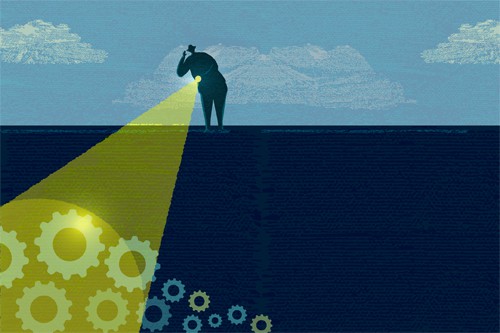
One of the tenets of forecasting is that there is knowledge to be gained from a review of the historical data. By examining history we gain insights into product performance and product response to various external (ex-trend) events. We also obtain insights into the forecasting process itself and ways by which to improve the process moving forward. What can we learn from the same retrospective analysis of forecasting, and how can we apply these insights to improve our approaches to pharmaceutical forecasting?
Forecasting has evolved over time as the environment has changed (see Table 1). In the 1970s the pharmaceutical markets were relatively uncomplicated, and complex strategic planning was not needed. In the 1980s a burgeoning global economy and relatively few restrictions on pharmaceutical pricing led to accelerating product growth. The need for forecasting again was low as companies basked in their commercial success.
| Forecasting eras | |
| 1970s | Age of Unplanning |
| 1980s | Delusions of Grandeur |
| 1990s | Age of Disappointment |
| 2000s | Era of Revitalisation |
| 2010s | Big Data Rules |
| 2020s | Wave of Biosimilars |
Table 1: Forecasting eras
In the early 1990s pressures on the pharmaceutical industry began to increase. Contraction in economies, pressure on pharmaceutical prices, increasing competitive pressure, and loss of marketing exclusivity on major products drove the need for more accurate planning and forecasting. Coming from a history of low need for forecasting, the industry struggled to develop the ‘science’ of forecasting. Disappointment resulted from the industry’s inexperience in forecasting.
The late 1990s and the beginning of the new century saw a growth in the application and sophistication of forecasting. In response to commercial pressure on the industry, strategic planning for the future took on greater importance and forecasting became a major contributor to the strategic planning function. In response to this need, the tools and methods available to the forecaster became more sophisticated and the ability to model various strategic options became viable.
In this current decade we are witnessing an explosion in the amount of data available to the pharmaceutical forecaster
In this current decade we are witnessing an explosion in the amount of data available to the pharmaceutical forecaster. This data ranges from anonymous patient-level data to more sophisticated datasets that track clinical trials and product development. In those countries where data have been scarce, but market potential high, we are seeing the emergence of nascent, disparate datasets. As information technology advances, data for these countries – such as China, India, and Russia – will become more readily available, enabling application of standards forecasting models in these emerging markets.
The resurgence continues today. Forecasting has become a keystone in future planning functions – such as strategic planning, business development and portfolio optimisation. The data available to the forecaster has increased substantially – ranging from physician-level prescribing data to anonymous patient-level consumption data. The processes, tools and methods available to the forecaster have continued to develop and actively contribute to the transformation of the forecasting function from a ‘numbers only’ exercise to a decision-driven strategic tool.
This transformation will take on increasing importance towards the end of this decade and the 2020s, as pharmaceutical markets again will enter a period of increased uncertainty. One key driver of uncertainty is the loss of market exclusivity for a number of biologic products and the entrance of biosimilars into these markets. The biologics that will lose exclusivity between now and 2020 represent over $55 billion in sales. There remains considerable uncertainty around projected performance for the biosimilar products and their effects on the innovator biologic. The forecaster is faced with modelling legal, regulatory and marketing uncertainty. Although challenging from a ‘point forecast’ perspective, this affords forecasting the opportunity to become more integrated as a strategic planning function.
Create stories, not spreadsheets
As discussed above, the role of the forecaster also evolved over time and continues to evolve into the future. In ‘forward-thinking’ organisations the forecasting position is no longer one of simple spreadsheet manipulation; rather, the forecaster has evolved into a holistic and insightful painter of the future.
This can be illustrated by a simple example. Consider three projects, whose point forecast returns to the company (as measured by risk-adjusted net present value). Project C has the highest risk-adjusted net present value and would be preferred over the other projects.
The decision, however, becomes less clear when the uncertainty ranges also are presented with each point estimate. Would you select Project C – which has a higher average risk-adjusted net present value, but little ‘upside potential’ and significant ‘downside risk’ – or Project A, which has a lower point estimate than Project C, but has higher ‘upside potential’ and lower ‘downside risk.’ There is no clear answer; the selection would depend upon the risk profile of the decision-makers and the corporate tolerance for risk.
Forecasting has become a keystone in future planning functions
How can the forecaster help in the decision-making? By communicating the ‘story’ behind each product forecast and not simply the point forecast. What is leading to the uncertainty? Can any of the uncertainty be resolved in the planning process? How were the uncertainty ranges determined? What is causing the average value for Project C to tend towards the high side of the uncertainty range? These are the key questions the decision-makers must ask, and the forecaster is in the position to better inform the decision-makers through each product’s story.
The ‘story’ being told by the forecaster may be as simple as the example above, or may be a more complex vision of the future. In this latter approach the forecaster develops different scenarios of the future and evaluates product performance (and uncertainty) in each of these alternative futures.
What are ‘alternative futures?’ This concept, sometimes referred to as ‘game theory’ or ‘war games,’ allows an organisation to evaluate different strategies for the future. The forecaster already is adept at drawing insights from historical data, capturing expert judgments, and evaluating these effects in structural modeling. By coupling identification of different scenarios in the future (alternative futures) with these skills, the forecaster can enable more strategic decision-making in organisations.
The integration of these concepts – diverse decision makers, sophisticated methods, broad relevance and strategic application – creates tremendous value and competitive advantage for an organisation. Forecasting eras of the past have shaped the forecaster of the future. The future of forecasting is its transformation from simple number reporting to offering these holistic frameworks in which to evaluate potential futures.





